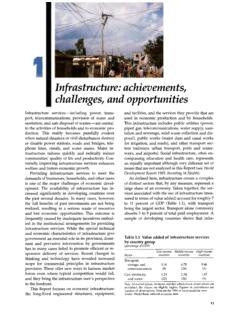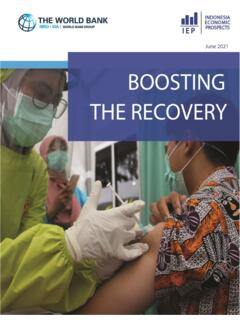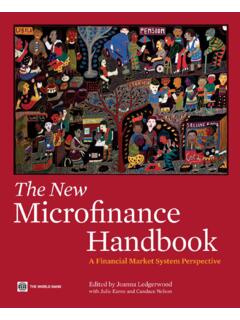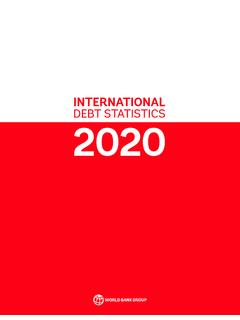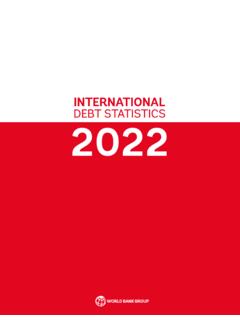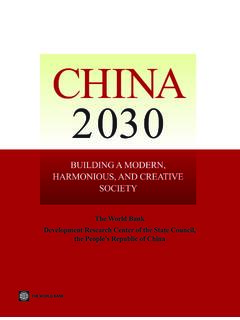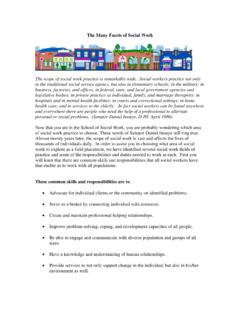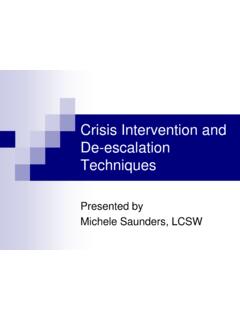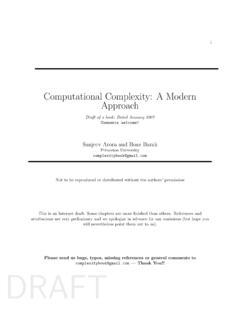Transcription of 5 The consequences of rapid population growth
1 5 The consequences of rapid population growthThis chapter shows that rapid populationgrowthat rates above 2 percent, common in mostdeveloping countries todayacts as a brake ondevelopment. Up to a point, population growthcan be accommodated: in the past three decadesmany countries have managed to raise averageincome even as their populations grew rapidly. Inthat strict sense, population growth has beenaccommodated. But the goal of developmentextends beyond accommodation of an ever largerpopulation; it is to improve people's lives. Rapidpopulation growth in developing countries hasresulted in less progress than might have beenlost opportunities for raising living standards, par-ticularly among the large numbers of the world' conclusion that rapid population growth hasslowed development is by no means straightfor-ward or clearcut (see Box ).
2 Under certain condi-tions moderate population growth can be benefi-cial. As Chapter 4 showed, in Europe, Japan, andNorth America economic growth has been accom-panied by moderate population growth , whichmay have stimulated demand, encouraged techno-logical innovation, and reduced investment labor force growth , combined with extraspending on education, can also mean continuousupgrading of the labor force with better educatedworkers. In sparsely populated countries, fasterpopulation growth shortens the time required toreach the population size that provides economiesof scale in transport, communications, socialser-vices, and production. Some developing countriescould benefit from such economies of scale, espe-cially in rural areas.
3 And a big population canincrease a country's economic as well as politicaland military power; in a world of economic andpolitical uncertainty, countries such as India andChina can seem to benefit from the sheer size oftheir domestic these benefits derive from a moderateincrease in population . Most developing countriesare experiencing growth that, by historical stand-ards, is faster than that. Even in uncrowded coun-tries, the long-term benefits of having more peoplemust be weighed against the immediate costs ofcoping with rapid growth . In those few countrieslacking the people to exploit their natural re-sources, immigration from neighboring countries,if politically feasible, would be less costly and moreeffective than a fast natural rate of populationgrowth.
4 And the economic success of many smallcountriesDenmark, Hong Kong, Singapore, andSwitzerlandshows that urbanization and tradeprovide other means to achieve the scale econo-mies of a large are several reasons why populationgrowth in developing countries is today a greatereconomic burden than it once was in today'sdeveloped countries: population growth is now much more Chapter 4 showed, in industrializing Europe itseldom exceeded percent a year, comparedwith the 2 to 4 percent that most developing coun-tries have averaged since World War nineteenth century Europe, large-scaleemigration from today's developing countries isnot with Europe, Japan, and NorthAmerica in their periods of fastest populationgrowth, income in developing countries isstilllow, human and physical capital are less built up.
5 And in some countries political and social institu-tions are less well developing countries whose economiesare still largely dependent on agriculture can nolonger draw on large tracts of unused chapter begins by emphasizing that theimplications of population growth differ consider-ably among countries, depending on their currentsocial, economic, and political conditions. Next itreviews how rapid population growth affects theeconomy as a whole through savings and invest-ment. It then considers the experience of countries79in coping with rapidly growing populationstheirefforts to achieve food security, the effects on theirnatural resources, the pressures of internal migra-tion and urban growth , and the options that theinternational economy provides.
6 Throughout this80 Box of population growth : conflicting viewsThe traditional Malthusian concern isthat population growth will sooner orlater run up against the limits of theearth's finite stock of resources. In hisFirst Essay on population , Maithus arguedthat the inherent capacity of populationto grow exceeds the earth s capacity toyield increases in food, because of limitsto the supply of cultivable land. Unre-strained population growth eventuallyleads to falling wages and rising foodpricesbecause,asthelaborforceexpands , a rising ratio of labor to landleads to smaller and smaller incrementsin output per worker. population growthis ultimately checked by rising the twentieth century this argumenthas been extended to the availability ofenergy and minerals, the effects of risingenvironmental pollution, and so on.
7 InThe Limits to growth , Club of Romeresearchers built a simulation model onthe assumption that the pace of techno-logical change would be insufficient toovercome diminishing returns arisingfromlimitedsuppliesofessentialres ources. Falling standards of living andincreasing levels of pollution would leadto a population collapse within 100 related view is that some resourcesland, forests, fixed, arerenewable, but that their sustainableyields do have a maximum limit. Someharvests may exceed this maximum, butthey lead to a permanent reduction in thelong-run productivity of land. A popula-tion whose needs (subsistence and com-mercial) exceed sustainable yields willhave lower per capita incomes in thelong claim of diminishing returns toresources can easily be criticized for itsfailure to recognize that, as resources aredepleted, rising prices reduce consump-tion and speed the search for substitutes,stimulating technological change.
8 Thiscriticism, extended, leads to the argu-ment that there are no real naturalresourcelimits,because populationgrowth itself brings the adjustments thatcontinually put off doomsday. To quotefrom Julian Simon's book, The UltimateResource: "The ultimate resource is peo-pleskilled, spirited, and hopeful peo-plewho will exert their wills and imagi-nations for their own benefit and so,inevitably, for the benefit of us all."Simon argues that natural resources arenot limited; that scarcity is revealed byprices; and that prices of resources arenot rising, at least not as a proportion ofthe income of the United States. Morepeople implies more ideas, more creativetalent, more skills, and thus better tech-nology; in the long run populationgrowthisnotaproblem but different viewpoints each con-tain important truths.
9 Some resourcesare finite; evenifprices have notincreased (and they may have done so inrelation to incomes outside the UnitedStates), there have been fundamentalstructuralchangesinthebalance between population and ingenuity might be a match forthese changes, but it might be able onlyto maintain income, not to lift millions ofpeople out of poverty. Or it may reducepoverty very slowly: even with theassumption of technological change builtinto Simon's model, there are "short-run" difficulties. His short run is thirtyto eighty years, and in that period hefinds even moderate population growthto be detrimental to human welfare. Inthe short run, ideas may be lost andEinsteins go undiscovered if many chil-dren receive little schooling.
10 Policy-makers and poor people live in the shortrun; they do not wish to go through aperiod of greater deprivation to adapteventually to rapid population the same time, there is little doubtthat the key to economic growth is peo-ple, and through people the advance ofhuman knowledge. Per capita measuresof income should not be used to implythat the denominator, people, contrib-utes nothing to the numerator, totalincome. Nor is population growth in andof itself the main cause of naturalresource problemsair pollution,soildegradation, even food Report therefore takes a positionthat is neither hopeless nor overly opti-mistic. The difficulties caused by rapidpopulation growth are not primarily dueto finite natural resources, at least not forthe world as a whole.



